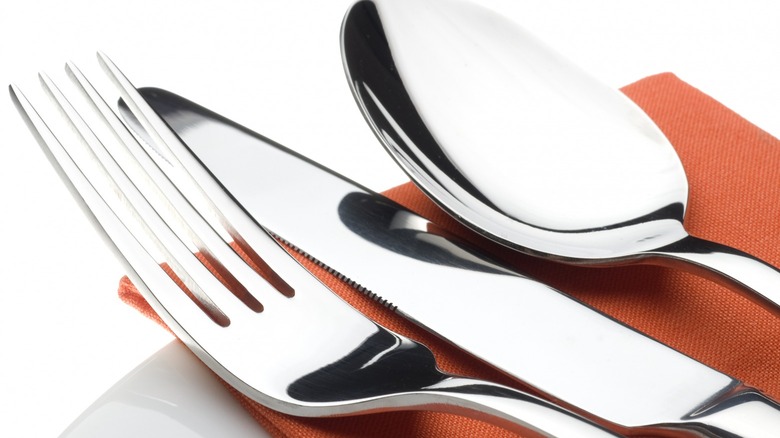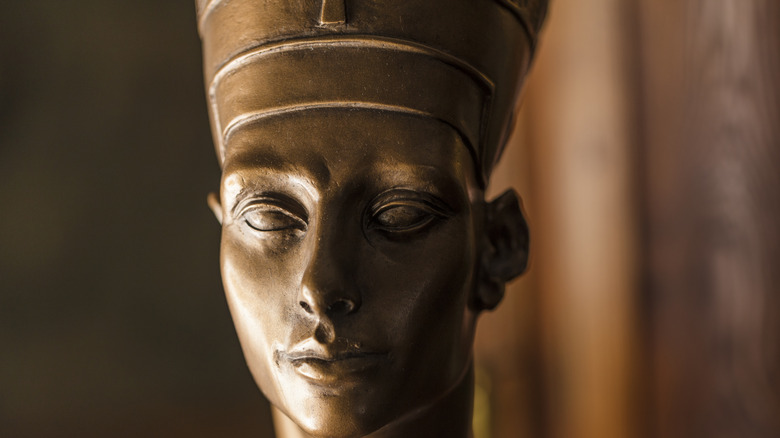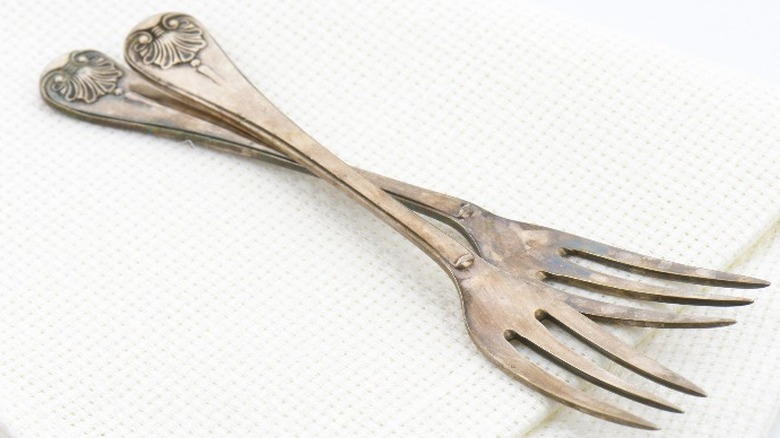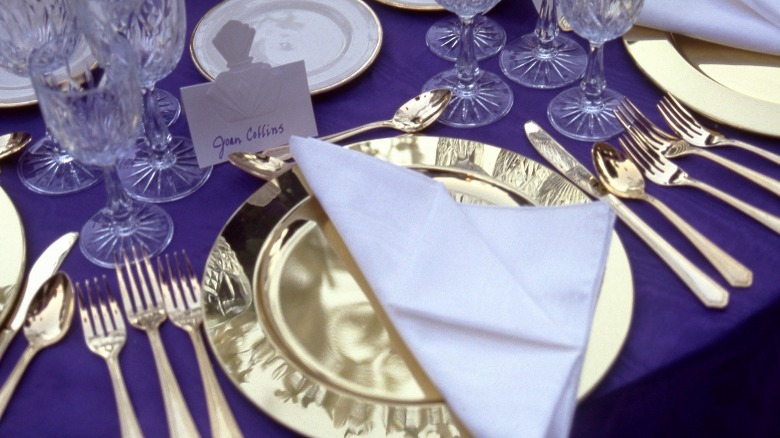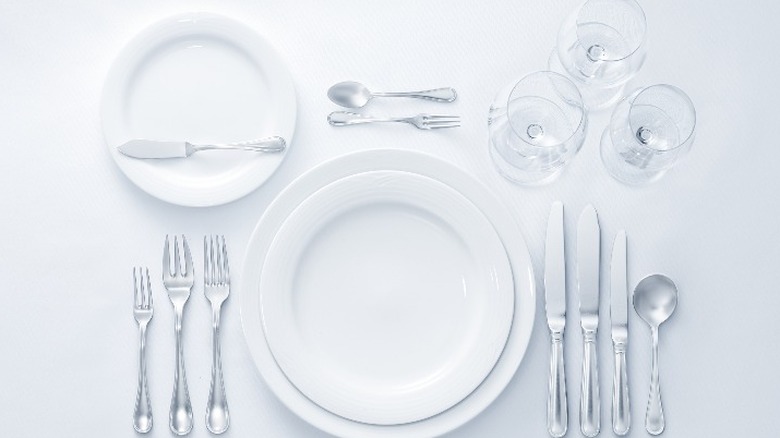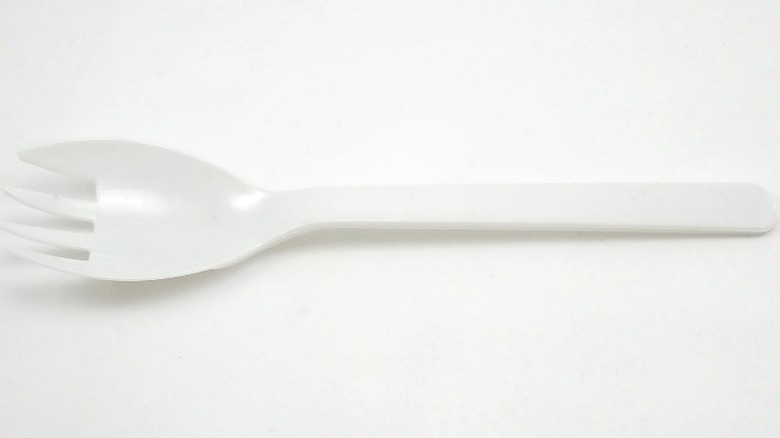11 Things You Might Not Know About Cutlery
Cutlery, flatware, utensils... whatever you call them, the humble fork, knife, and spoon are essential tools in helping us enjoy our food, whether dining at home alone, at work, with friends in a restaurant, or anywhere else. Most of us never stop to think about when cutlery was first used, and why — as it turns out, the history of cutlery is actually pretty interesting.
For example, did you know the knives we use today are very different from those used throughout history? Or that the fork was once considered evil? There's even a good reason why disposable chopsticks exist — and it's probably not the one you'd expect.
With so many fascinating things to learn about cutlery, it's time to dig deep into the history, culture, and superstitions surrounding these everyday implements. From the fork, knife, and spoon to the importance of how you set out your flatware once you've finished your meal, read on for 11 things you might not know about cutlery.
The Ancient Egyptians invented dining etiquette
To understand the history of the cutlery used today, it's important to know a little about the history of dining etiquette. Though you'd be forgiven for thinking it's a modern construct, etiquette surrounding how people eat dates back to Ancient Egypt.
At this time, "The Instruction of Ptahhotep" was created. This written code for dining etiquette came into existence during the reign of Pharaoh Djedkare lsesi, sometime between 2414-2375 BC. Of course, humans followed rules and customs surrounding dining before that — this was just the first time something had been put down in writing.
Almost every ancient empire had its own rules. In the Roman Empire, diners sat on pillows surrounding a low, small table. Two types of spoons were used — probably carved from bone, wood, or shell — to consume food, and the hands were also used. Despite the use of spoons during this period, however, cutlery didn't really become commonplace until much later.
Cutlery took off in the 1800s
Though spoons and knives have been around in some shape or form for thousands of years, it wasn't until the Age of Renaissance, and the Age of Baroque and Enlightenment, that spoons, forks, and knives were introduced across Europe — and later, the U.S. Prior to this, iron knives weren't used as eating utensils until around 1000 BC. Spoons carved from wood, shell, or bone were commonly used in Ancient Egypt and Ancient Rome, with forks also used for cooking — though not for eating — in Ancient Egypt.
However, it wasn't until 1533 that forks made it onto European dining tables. King Henry II's wife, Catherine De Medici, brought a selection of forks back to France following a trip to Italy, and they became a trend.
Forks then looked a bit different from the three and four-tined forks we're used to today, as they had only two tines. The extra tines weren't added until the early 1700s in Germany. By the 1800s, forks, knives, and spoons had become a common fixture on dining tables in most western homes.
Cutlery became a trend in the 16th century
In many parts of the world, it's still commonplace to eat with your hands. Some claim food tastes better that way, and research has shown that eating with heavier cutlery makes food taste better. One experiment carried out in Scotland even showed that diners were willing to pay 15% more for their meal when dining with high-quality silverware as opposed to cheaper cutlery. Aside from this, there are several scientific reasons why eating food with your hands is a good idea.
Believe it or not, eating with your hands can help improve digestion, due to the Normal Flora bacteria on our hands that protects our bodies. Using your hands also increases circulation, and ensures you'll eat more slowly, fully digesting your food. Since we wash our hands multiple times throughout the day, many people believe it's more hygienic to eat with your hands than using cutlery, which is only washed once.
So, why do we use cutlery? It might sound strange, but during the 16th century, after Catherine De Medici introduced forks to Europe, they became such a huge trend that they just... stuck around. By the early 19th century, we were all using cutlery for dining — well, except for cultures where eating with your hands or chopsticks remains preferred.
Knives are the oldest eating utensils
Did you know knives are the oldest eating utensils, dating back thousands of years? Once made from flint or bone, it wasn't until the Bronze Age (3000-700 BC) that metal knives forged from bronze and copper were typically used for dining.
During the Iron Age and Steel Age, knives became commonplace, but it was also common that hosts didn't provide guests with cutlery. Instead, guests brought their own small, sharp-tipped knives, which could be used for spearing and eating meat. The same knife was often also employed for fighting.
During the reign of King Louis XIV of France in the 17th century, knives changed forever. On May 14, 1637, the King's advisor, Cardinal Richelieu, ordered the blades of knives used at the table to be ground down. These rounded-off knives soon became popular throughout the court, with their popularity spreading across France.
While the King probably had his own reasons for removing sharp, pointed knives from the hands of his dining companions, the rounded-off knives became a hit. Soon these new, undeniably more practical knives took off across Europe and the U.K., then carried over to the American colonies.
Forks were once considered evil
If you think the history of the knife is interesting, wait until you hear about forks. The word fork originates from the Latin word furca, meaning pitchfork. Originally, forks had just two tines, later three. But they didn't become commonplace until about 1,000 years ago.
The story goes that their first appearance was in 1004. Maria Argyropoulina, the Greek niece of the Byzantine emperors Basil II and Constantine VIII, married the son of the Doge of Venice. Arriving at her wedding in Venice, she brought a case containing two tiny golden forks with her to eat her wedding feast.
Three years later, when Maria died of the plague, Saint Peter Damian declared that the fork must have come from the devil; its tines resembled horns, and he felt that Maria's death was "God's punishment." Following this proclamation, forks never really took off in Europe.
It wasn't until Catherine De Medici, wife of King Henry II, introduced them to Europe in the 16th century that their popularity began to spread. Forks came to the U.S. much later than the rest of the world, too. They weren't used in Northern American colonies until the early 19th century, when German-made multi-tined forks arrived in the U.S.
Spoons were once a mark of wealth and power
The word "spoon" is an Anglo-Saxon word, meaning a chip of wood. The humble spoon date back to Paleolithic times, when small bowls resembling modern spoons were used to scoop and hold liquid. In Ancient Rome, wood was carved into spoons; the Greeks used sea shells, and the Ancient Egyptians used gold or silver, often with intricately-carved designs and only for the elite.
In Europe in the Middle Ages, wooden spoons and those forged from pewter, brass, and even cow horns became popular. Today there are over 50 varieties of spoons in existence, including tablespoons and teaspoons (also used as a unit of measurement), sugar spoons, soup spoons, dessert spoons, grapefruit spoons with their serrated edge, and even caviar spoons, which are never made from metal that could impact the flavor of the caviar.
Then there are spoons used for cooking, such as ladles, slotted spoons, risotto spoons, and serving spoons. Don't forget plastic baby spoons for feeding infants, coffee measuring spoons, and demitasse or espresso spoons, designed for use with tiny espresso cups. So many different spoons, so many different uses.
Spoons weren't always for eating and cooking, though. In England, they were once a mark of wealth and power. The Coronation of every king of England is followed by the anointing, where a special Coronation Spoon is used. Holy oil is poured into the spoon and the future king is anointed on the head, hands, and breast, an ancient tradition dating back thousands of years.
Chopsticks have ancient roots
Though not every family in the U.S. uses chopsticks regularly, they are widely in use across most Asian countries and many other parts of the world. With roots even more ancient than the knife or fork, chopsticks predate the latter by about 4,500 years and were created during the Shang Dynasty (1755-1122 BC), before spreading to Japan, Korea, and Vietnam. During their early days in Japan, chopsticks were only used for religious ceremonies, never for cooking or eating.
The oldest discovered chopsticks came from the ruins of the city of Yen near Anyans, Henan, dating back 3,200 years. These huge chopsticks were made from bronze but were likely used as a cooking utensil rather than for eating.
In modern society, you're most likely to come across waribashi, or disposable chopsticks. These are generally made from wood and often given away with Japanese or Chinese takeout, at sushi bars, or in other Asian restaurants. Waribashi first became popular in Japanese restaurants in the 18th century, but the reason for their existence is an interesting story.
There's an ancient Shinto belief that you should never use something somebody else has put in their mouth — such as a fork, or chopsticks, for example. This is because the item is believed to have absorbed aspects of that person's personality. For this reason, waribashi became commonplace, so chopsticks were single-use only. Today China uses over 45 billion pairs of chopsticks annually. In Japan, over 24 billion pairs are used every year.
Cutlery is held differently depending on where you live
The U.S. has a different way of holding utensils than much of the rest of the world. Here, the fork is held in the left hand to steady food, with the knife held in the right, to cut the food. However, once the diner is ready to eat, the fork is traditionally transferred to the right hand. While not everyone in the U.S. eats this way, it's the most common dining etiquette, even though it doesn't really work for left-handed people.
In the U.K. and the rest of Europe, left-handed people can eat with their left hand if they prefer. The fork is still generally held in the left hand, with the knife in the right. However, the fork remains in the left hand when transferring food to your mouth.
Travel to India, and you'll find people generally use their hands for eating, though in some northern regions and in most tourist restaurants, you'll find forks and spoons. Only the right hand is used for eating, as Hinduism considers the right hand to be the clean one. Eating with your left hand just isn't done; it is seen as rude.
In Thailand, it's common to use chopsticks for noodle soup, but a fork and spoon for other meals:. Never a knife. Food is cut and moved onto the spoon with the fork. Diners then use the spoon to transfer food to their mouths.
How to use cutlery during a formal dinner
Everyone remembers the scene from "Pretty Woman" where Julia Roberts learns how to use cutlery at a formal dinner. The general rule — as learned from the movie — is to work from the outside in. If in doubt, always follow your host's lead.
At any formal dinner table, you will find the forks on the left of the plate, with the salad fork on the outside and the dinner fork next to your plate. To the right of the plate (from the outside in), you have the soup spoon, spoon, salad knife, and knife. You may also have an oyster fork which sits to the right of everything else. Depending on what you're being served, you may not have all these options.
The fork and knife closest to your plate are the ones to use for your main course. But what do you use for dessert? Your dessert fork and/or spoon will normally be set above your plate, parallel to it. For some formal occasions and in some upmarket restaurants, the dessert utensils may be set on the dessert plate.
How you position your cutlery matters
Now you know which cutlery to use and when. But did you know that how you position your cutlery also matters?
Placing your fork and knife in an upside-down V position, or resting your knife at the top of the plate, indicates that you're still eating. When you've finished your meal, place your knife and fork in the center of the plate, parallel to each other — the ideal is a 12 o'clock position.
Between your entree and main course, you should place your knife in a cross formation underneath your fork, with the knife pointing horizontally and the fork pointing vertically. If you want to signal that your meal was excellent once you've finished eating, just place your knife and fork horizontally across the plate so that the tines and blade are pointing right.
What if you didn't enjoy your meal? Place your knife's blade through the fork's tines in a V shape. It's worth noting that not all of these are commonly employed and understood everywhere, but remembering the basics to indicate you have finished (or not finished) eating could be helpful.
Utensils are placed on a table in order of use (outside in)
We already covered that you should use cutlery working from the outside in at a formal dinner, but you'll need to remember this rule when setting a table for guests, too. There are other things you should also consider to ensure you don't commit an etiquette faux pas.
There's no need to set the table with utensils you won't use. For example, if you're not serving soup, don't place soup spoons on the table. No oysters at your dinner? Then there's no need for an oyster fork.
Forks always go to the left of the plate, with knives and spoons to the right. However, there are a couple of notable exceptions. Dessert spoons (and forks) always go above the plate, positioned parallel to it. If you're using an oyster fork, that goes to the right of the plate, outside the rest of the cutlery.
If this all seems a bit confusing, you're not alone. If you're setting a formal table yourself, you can find plenty of diagrams and videos online to help.
Hybrid utensils are a modern-day thing
Dining behaviors sure have come a long way since the invention of the table knife, fork, and spoon. That doesn't mean, however, that humanity has stopped inventing new cutlery. Modern society has seen the rise of cutlery hybrids, including the most popular ones, like the spork, knork, and splayd.
The spork is older than you might think; long before you could get one at Taco Bell, it was invented in the late 19th century. The first patent, from 1874, was granted to Samuel W. Francis, a doctor from Rhode Island, for a spoon-like scoop with tines and a knife edge on the side of the spoon. During the 1800s, sporks were known as ice cream or terrapin forks. Today, they're commonly used by hikers or campers, the military, in prison, and for airplane meals.
The knork is a knife and fork hybrid that's usually made from plastic, with a serrated cutting edge and three tines. It was invented by Mike Miller, an eighth grader who conceived the idea while trying to cut pizza with a fork in a restaurant in Newton, Kansas. The knork is commonly found on airplanes, used for takeout food, or by anyone with a physical disability that affects their hand function.
The Splayd is a spoon, knife, and fork in one. Invented by Australian William McArthur in the 1940s, it was later introduced in his wife's cafe in Sydney. By the 1960s, mass production began, and the splayd has since been popping up at BBQs and buffets worldwide.
